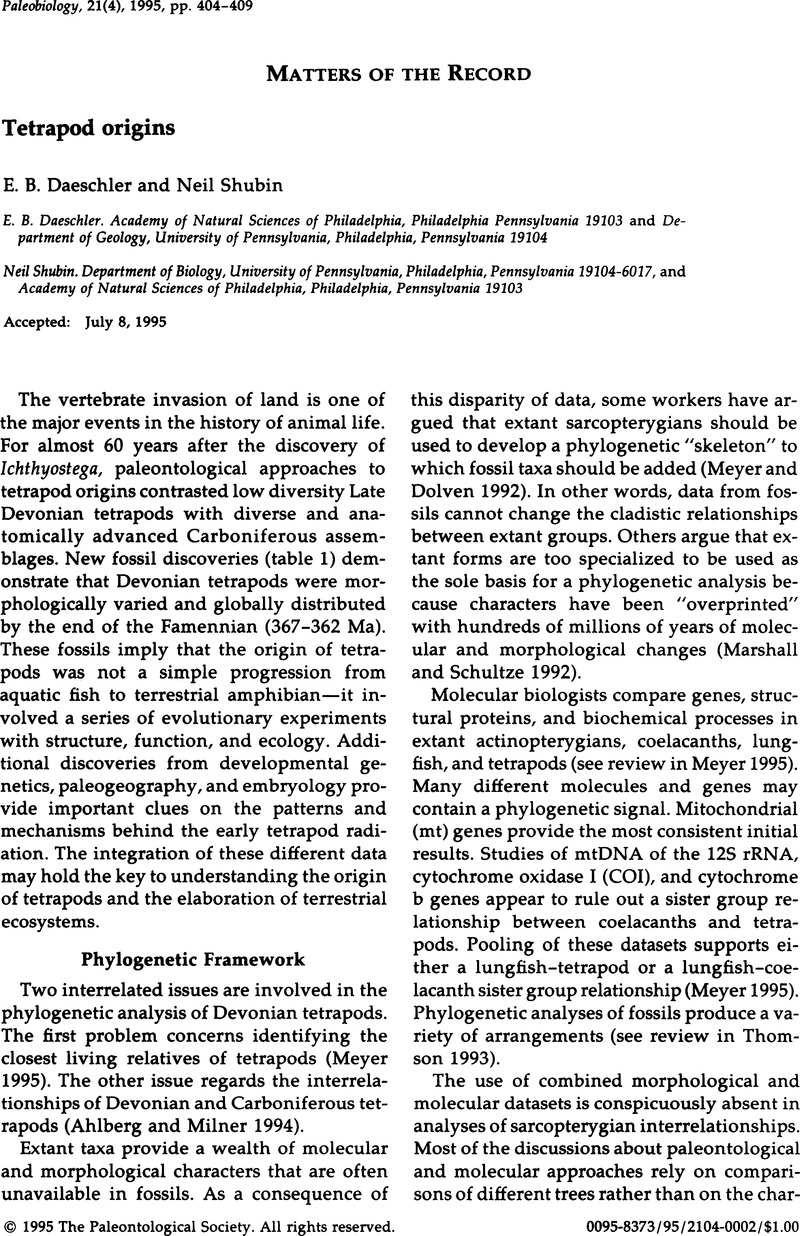Crossref Citations
This article has been cited by the following publications. This list is generated based on data provided by Crossref.
Coates, M. I.
1996.
The Devonian tetrapodAcanthostega gunnariJarvik: postcranial anatomy, basal tetrapod interrelationships and patterns of skeletal evolution.
Transactions of the Royal Society of Edinburgh: Earth Sciences,
Vol. 87,
Issue. 3,
p.
363.
Clack, J.A.
1997.
Devonian tetrapod trackways and trackmakers; a review of the fossils and footprints.
Palaeogeography, Palaeoclimatology, Palaeoecology,
Vol. 130,
Issue. 1-4,
p.
227.
Farmer, Colleen
1997.
Did lungs and the intracardiac shunt evolve to oxygenate the heart in vertebrates?.
Paleobiology,
Vol. 23,
Issue. 3,
p.
358.
Thomson, Keith Stewart
Shubin, Neil S.
and
Poole, Forrest G.
1998.
A problematic early tetrapod from the Mississippian of Nevada.
Journal of Vertebrate Paleontology,
Vol. 18,
Issue. 2,
p.
315.
JANIS, CHRISTINE M.
and
FARMER, COLLEEN
1999.
Proposed habitats of early tetrapods: gills, kidneys, and the water-land transition.
Zoological Journal of the Linnean Society,
Vol. 126,
Issue. 1,
p.
117.
DAESCHLER, EDWARD B.
2000.
EARLY TETRAPOD JAWS FROM THE LATE DEVONIAN OF PENNSYLVANIA, USA.
Journal of Paleontology,
Vol. 74,
Issue. 2,
p.
301.
Long, John A.
and
Gordon, Malcolm S.
2004.
The Greatest Step in Vertebrate History: A Paleobiological Review of the Fish‐Tetrapod Transition.
Physiological and Biochemical Zoology,
Vol. 77,
Issue. 5,
p.
700.
Greene, Harry W.
2007.
Novartis Foundation Symposium 222 ‐ Homology.
p.
173.
Cabej, Nelson R.
2012.
Epigenetic Principles of Evolution.
p.
449.
Robin, Ninon
Noirit, Florian
Chevrinais, Marion
Clément, Gaël
Olive, Sébastien
and
Marchetti, Lorenzo
2022.
Vertebrate predation in the Late Devonian evidenced by bite traces and regurgitations: implications within an early tetrapod freshwater ecosystem.
Papers in Palaeontology,
Vol. 8,
Issue. 4,
Buser, Thaddaeus J.
Kee, Victoria E.
Terry, Rebecca C.
Summers, Adam P.
and
Sidlauskas, Brian L.
2023.
Taurus of the Tidepool? Inferring the Function of Cranial Weapons in Intertidal Sculpins (Pisces: Cottoidea: Oligocottinae).
Ichthyology & Herpetology,
Vol. 111,
Issue. 1,



